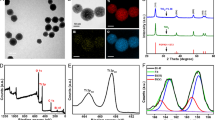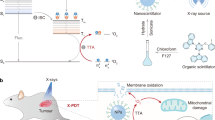Abstract
For a development of deep tumor treatment in photodynamic therapy, a feasibility of novel radiosensitizers induced by x-ray was investigated. The sensitizers are designed to generate reactive oxygen species (ROS) inside or outside the cell, possibly leading to damage exclusively on tumor cells and reservation of normal cells along the x-ray path. Taking note of the similarity in energy transfer mechanism in photocatalysts, scintillators, and particulate semiconductors, we chose TiO2, ZnS:Ag, CeF3, and quantum dots (CdTe and CdSe) in particulate form, which contain heavy atoms for efficient absorption of x-rays. A parameter study for x-ray operating conditions showed that in a typical scenario, photons with 20 to 170 keV energy are attenuated by 90% through the region of particle dispersed aqueous solution at varying concentration between 0.01 and 100 wt%. The amount of ROS generation under the exposure of polychromatic x-ray was measured using dihydroethidium reagent which detects an integrated amount of several species. Proportional increase in ROS generation to x-ray dose was observed for varying concentrations of TiO2, ZnS:Ag, CeF3, and CdSe quantum dot dispersions. Then, HeLa cells were mixed with aqueous solutions dispersed with sensitizing materials at a concentration of 3.0 mg/ml and were exposed to x-ray. Their survival fraction obtained by a cell proliferation reagent WST-1 immediately after the irradiation showed insignificant effects of sensitizing materials except at large doses. To enhance the sensitization effect, bio-conjugated CdSe quantum dots were internalized in the cytoplasm up to a concentration of 1.0 ng/ml. The cells were irradiated by x-ray up to 5 Gy, and their survival fraction was measured by the colony forming ability 9 days after irradiation. Survival fraction of the cells treated with quantum dots were less than those without quantum dots for all doses, suggesting that the colony forming ability is impaired by the internalized quantum dots.







Similar content being viewed by others
References
Henderson BW, Dougherty TJ. Photodynamic therapy. New York: Mercel Dekker; 1992.
Dolmans DEJGJ, et al. Nat Rev Cancer. 2003;3(5):380–7.
Brown S, Brown EA, Walker I. Lancet Oncol. 2004;5:497–508.
Cohen L, Schwartz S. Cancer Res. 1966;26:1969.
Rotman M, Aziz H, Wasserman T. Chemotherapy and irradiation: principle and practice of radiation oncology. 3rd ed. PA: Lippincot-Raven Publishers; 1997.
Wang X, Ohnishi T. J Radiat Res. 1997;38:179–94.
Mauceri HJ, Hanna NN, Beckett MA, et al. Nature. 1998;394:287–91.
Cai R, Kubota Y, Shuin T, Sakai H, Hashimoto K, Fujishima A. Cancer Res. 1992;52:2346.
Bakakova R, et al. Nat Biotechnol. 2004;22:1360–1.
Bakalova R, Ohba H, Zhelev Z, Nagase T, Jose R, Ishikawa M, Baba Y. Nano Lett. 2004;4(9):1567–73.
NIST. Standard Reference Database 8 (XGAM), NIST X-Ray and Gamma-Ray Attenuation Coefficients and Cross Sections Database, ver.1.3; 2005.
Zuo L, et al. Am J Physiol Cell Physiol. 2000;279:C1058–66.
Ollis DF, Al-Ekabi H, Ed. Photocatalytic purification and treatment of water and air. Amsterdam: Elsevier; 1993.
Medintz L, Ueda T, Goldman E, Mattoussi H. Nature Materials. 2005;4:435–45.
Elkind MM, Sutton H. Radiat Res. 1966;13(4):556–93.
Kajiwara K, Fujii G, Saito A, Tanihara M. Photon Factory Activity Report 2002, 2003;20B:259.
Kobayashi K, Usami N, Maezawa H, Hayashi T, Hieda K, Takakura K. Journal of Biomedical Nanotechnology. 2006;2(2):116–9.
Kobayashi K, Frohlich H, Usami N, Takakura K, LeSech C. Radiat Res. 2002;157:32.
Jaiswal JK, Mattoussi H, Mauro JM, Simon SM. Nat Biotechnol. 2003;21(1):47–51.
Voura EB, Jaiswal JK, Mattoussi H, Simon SM. Nat Med. 2004;10(9):993–8.
Derfus AM, Chan WCW, Bhatia SN. Nano Lett. 2004;4:11–8.
Semmler M, Seitz J, Erbe F, Mayer P, Heyder J, Oberdorster G, Kreyling WG. Inhal Toxicol. 2004;16(6–7):453–9.
Author information
Authors and Affiliations
Corresponding author
Rights and permissions
About this article
Cite this article
Takahashi, J., Misawa, M. Analysis of Potential Radiosensitizing Materials for X-Ray-Induced Photodynamic Therapy. Nanobiotechnol 3, 116–126 (2007). https://doi.org/10.1007/s12030-008-9009-x
Published:
Issue Date:
DOI: https://doi.org/10.1007/s12030-008-9009-x




